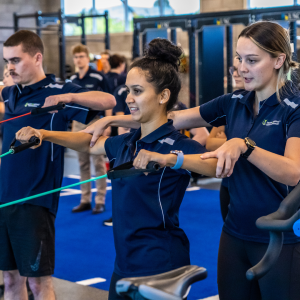
Back pain is a pervasive issue globally, affecting people of all ages and backgrounds. It’s not merely an inconvenience but a significant health concern that can disrupt daily activities, reduce productivity, and impair overall quality of life. Addressing back pain early is crucial to prevent it from becoming chronic and potentially leading to more severe complications down the road.
Understanding the Causes of Back Pain
Understanding the root causes of back pain is essential for effective management and prevention. Here are some common causes:
- Poor Posture: Incorrect posture, whether sitting, standing, or lifting objects, can strain the muscles and ligaments supporting the spine, leading to pain over time.
- Muscle Strain: Overuse, improper lifting techniques, sudden movements, or strenuous activities can strain the muscles and soft tissues in the back, causing acute or chronic pain.
- Injuries: Accidents, falls, sports injuries, or trauma can result in fractures, sprains, or strains in the back, leading to acute pain.
- Herniated Discs: When the soft cushion-like discs between the vertebrae rupture or bulge, they can press on nerves, causing pain that radiates down the legs (sciatica).
- Arthritis: Osteoarthritis and other forms of arthritis can affect the spine, causing inflammation, stiffness, and pain.
- Sciatica: Compression or irritation of the sciatic nerve, often due to a herniated disc or bone spur, can cause sharp, shooting pain that radiates from the lower back down the leg.
Identifying the specific cause of your back pain is crucial for developing an effective treatment plan. Sometimes, multiple factors may contribute to the pain, requiring a comprehensive approach to management.
Lifestyle and Posture Adjustments
Maintaining good posture and making necessary lifestyle adjustments are key components of managing and preventing back pain. Here’s how you can improve your posture and make ergonomic adjustments at home and in the workplace.
Importance of Good Posture
Good posture ensures that your spine is aligned correctly, reducing strain on muscles and joints. It helps distribute body weight evenly and supports the natural curves of the spine, promoting overall spinal health and preventing back pain.
Tips for Maintaining Proper Posture
- While Standing
-
-
- Keep your feet shoulder-width apart.
- Balance your weight evenly on both feet.
- Tuck in your abdomen and avoid locking your knees.
- Stand straight with your shoulders back and relaxed.
-
- While Sitting
-
-
- Use a chair with good lower back support or place a small pillow behind your lower back.
- Keep your feet flat on the floor or on a footrest.
- Knees should be at or slightly below hip level, with thighs parallel to the ground.
- Sit back in your chair and maintain the natural curve of your spine.
-
- While Sleeping
-
- Use a mattress that supports the natural curve of your spine. Medium-firm mattresses are generally recommended.
- Sleep on your side with knees bent or on your back with a pillow under your knees for support.
Ergonomic Adjustments for Home and Workplace
- Workstation Setup
-
-
- Adjust your chair height so that your feet rest flat on the floor and your knees are level with your hips.
- Position your computer monitor at eye level and about an arm’s length away.
- Use an ergonomic keyboard and mouse to minimise strain on your hands and wrists.
-
- Lifting and Carrying
-
- Bend your knees and keep your back straight when lifting heavy objects.
- Avoid twisting your body while lifting; instead, pivot your feet.
- Distribute weight evenly when carrying bags or backpacks.
By incorporating these tips into your daily routine, you can improve your posture, reduce the risk of back pain, and enhance overall spinal health.
Applying Heat and Cold Therapy
- Heat Therapy
-
-
- Apply a heating pad or hot water bottle to the affected area for 15-20 minutes.
- Warm showers or baths can also help relax muscles and alleviate stiffness.
- Heat increases blood flow to the area, which can promote healing and reduce muscle spasms.
-
- Cold Therapy
-
- Use an ice pack wrapped in a towel and apply it to the painful area for 10-15 minutes.
- Cold therapy helps reduce inflammation and numbs the affected area, providing temporary pain relief.
- Avoid applying ice directly to the skin to prevent frostbite.
Massage and Manual Therapy

- Massage Therapy
-
-
- Professional massage therapy or self-massage techniques can help relax tight muscles and improve circulation.
- Techniques such as Swedish massage, deep tissue massage, and trigger point therapy can target specific areas of pain.
-
- Manual Therapy
-
- Chiropractic adjustments or osteopathic manipulative treatment (OMT) can help realign the spine and relieve pressure on nerves.
- Physical therapists may perform manual therapy techniques such as joint mobilisation or soft tissue manipulation to improve range of motion and reduce pain.
Incorporating these pain management techniques into your daily routine can help alleviate discomfort and improve your overall quality of life. Always consult with a healthcare professional before starting any new pain management regimen, especially if you have underlying health conditions or are taking medications.
If you’re looking for more personalised guidance on managing your pain effectively, consider reaching out to a healthcare provider or pain management specialist such as Total Rehab Solutions by calling 1300 685 046 or filling out the contact form here.
Daily Habits to Prevent Back Pain

Incorporating daily habits that promote back health can significantly reduce the risk of developing or exacerbating back pain. Here are essential practices to integrate into your routine.
Maintaining a Healthy Weight
- Importance of Weight Management
-
-
- Maintaining a healthy weight reduces stress on your spine and supporting muscles, minimising the risk of back pain.
- Excess weight can strain the lower back, contributing to conditions like herniated discs and osteoarthritis.
-
- Strategies for Weight Control
-
- Eat a balanced diet rich in fruits, vegetables, lean proteins, and whole grains to support overall health and weight management.
- Incorporate regular physical activity into your routine, such as walking, swimming, or yoga, to promote weight loss and strengthen core muscles.
Proper Techniques for Lifting and Bending
- Lifting Techniques
-
-
- Bend your knees and keep your back straight when lifting objects from the ground.
- Use your leg muscles to lift, rather than relying on your back, to prevent strain and injury.
- Avoid twisting your body while lifting; instead, pivot your feet to face the direction you need to go.
-
- Bending Techniques
-
- When bending to pick up objects, hinge at the hips rather than bending at the waist.
- Maintain a neutral spine position to distribute weight evenly and reduce pressure on the lower back.
- Engage your core muscles to stabilise your spine while bending and avoid overstretching or straining your back muscles.
Creating a Sleep Environment that Supports Back Health
- Choosing a Mattress and Pillow
-
-
- Select a mattress that provides adequate support for your spine’s natural curvature, whether firm or medium-firm, based on personal preference.
- Use pillows that support your neck and maintain alignment with your spine while sleeping on your side, back, or stomach.
-
- Sleeping Positions
-
- Avoid sleeping on your stomach as it can strain your neck and lower back.
- Sleeping on your side or back with a pillow between your knees can help maintain spinal alignment and reduce pressure on your back.
Incorporating these daily habits into your lifestyle can help prevent back pain and promote overall spinal health. Consistency and mindfulness in your daily activities, along with regular exercise and maintaining a healthy weight, are key to maintaining a strong and resilient back.
Mind-Body Connection
Understanding the mind-body connection is crucial in managing and preventing back pain. Here’s how stress and mental health impact back pain, along with relaxation and mindfulness techniques to alleviate discomfort.
Role of Stress and Mental Health in Back Pain
- Impact of Stress on Back Pain
-
-
- Stress contributes to muscle tension and can exacerbate existing back pain.
- Chronic stress increases inflammation throughout the body, potentially worsening conditions like arthritis or herniated discs.
-
- Psychological Factors
-
- Anxiety and depression can alter pain perception and lower pain tolerance, amplifying the experience of back pain.
- Psychological stressors may lead to poor posture and unhealthy coping behaviours that strain the back muscles.
Relaxation Techniques

- Meditation
-
-
- Practice mindfulness meditation to reduce stress and promote relaxation.
- Focus on deep breathing and present-moment awareness to alleviate muscle tension and calm the mind.
-
- Deep Breathing Exercises
-
- Perform diaphragmatic breathing by inhaling deeply through your nose, expanding your abdomen, and exhaling slowly through your mouth.
- Deep breathing increases oxygen flow, relaxes muscles, and reduces stress hormones that contribute to back pain.
Incorporating Mindfulness Practices
- Mindful Movement
-
-
- Engage in gentle exercises like yoga or tai chi to improve flexibility, strengthen core muscles, and enhance body awareness.
- Mindful movement promotes proper posture and reduces the risk of muscle strain that can lead to back pain.
-
- Daily Mindfulness
-
- Practice being present in daily activities, such as walking, eating, or working, to reduce stress and prevent mental fatigue.
- Incorporate short mindfulness sessions throughout the day to stay attuned to your body’s signals and reduce tension in the back and neck.
By integrating these relaxation and mindfulness techniques into your daily routine, you can alleviate stress, improve mental well-being, and manage or prevent back pain effectively. Developing awareness of the mind-body connection empowers you to take proactive steps toward maintaining a healthy back and overall physical health.
Long-Term Back Health Strategies
Maintaining a healthy back requires proactive strategies that prioritise regular care and lifestyle adjustments. Here are essential practices to promote long-term back health.
Importance of Regular Check-Ups
- Scheduled Evaluations
-
-
- Visit your healthcare provider for routine check-ups to assess spine health and identify early signs of potential issues.
- Regular examinations enable timely intervention and prevent the progression of back-related conditions.
-
- Diagnostic Assessments
-
- Undergo diagnostic tests like X-rays or MRI scans as recommended by your healthcare provider.
- These assessments help in detecting spinal abnormalities, such as herniated discs or osteoarthritis, which may impact long-term back health.
Developing a Sustainable Back Care Routine
- Exercise and Strength Training
-
-
- Incorporate regular exercise routines that focus on strengthening core muscles, which support the spine and improve posture.
- Activities such as swimming, walking, or yoga can enhance flexibility and reduce the risk of strain on the back.
-
- Proper Body Mechanics
-
-
- Practise correct lifting techniques by bending your knees and keeping the object close to your body to avoid straining the back muscles.
- Maintain good posture while sitting and standing to alleviate pressure on the spine and reduce the risk of developing chronic back pain.
-
- Ergonomic Adjustments
-
- Modify workstations and home environments to support back health.
- Use ergonomic chairs, desks, and pillows that promote neutral spine alignment and minimise strain during prolonged sitting or sleeping.
Adapting Habits and Practices as You Age
- Nutrition and Hydration
-
-
- Maintain a balanced diet rich in essential nutrients like calcium and vitamin D to support bone health and prevent osteoporosis.
- Stay hydrated to keep spinal discs hydrated and maintain their shock-absorbing properties.
-
- Mindful Aging
-
-
- Stay physically active while respecting your body’s limitations as you age.
- Adjust exercise intensity and duration to prevent injuries and promote overall well-being.
-
- Stress Management and Mental Health
-
- Practice stress-relief techniques such as meditation, deep breathing, or hobbies that promote relaxation.
- Manage mental health to reduce tension in the back muscles and alleviate stress-related back pain.
By integrating these long-term strategies into your lifestyle, you can nurture a healthy spine and mitigate the risk of chronic back problems. Consistency in proactive care and adopting healthy habits tailored to your needs support overall back health and enhance quality of life as you age.
Incorporating proper posture, regular exercise, and mindful habits can significantly alleviate back pain. Consistency is key to maintaining spinal health and overall well-being. Implement these tips today to enjoy a pain-free back and improved quality of life. For personalised guidance and expert care, contact Total Rehab Solutions. Our dedicated team is ready to assist you in achieving optimal back health. Reach out today by calling us at 1300 685 046 or filling out our contact form here.
